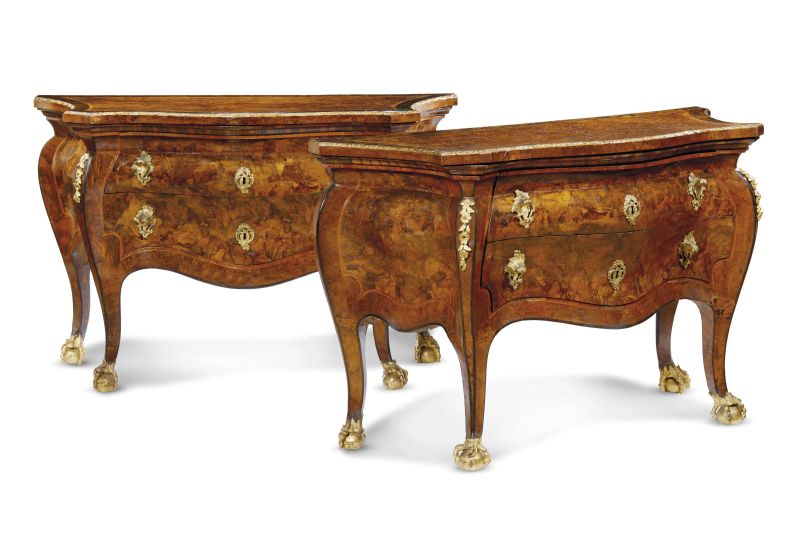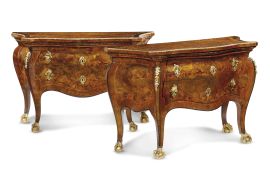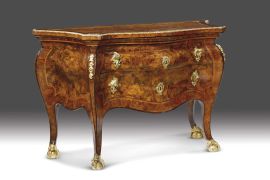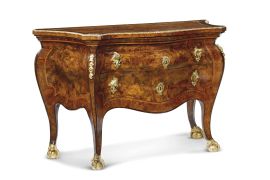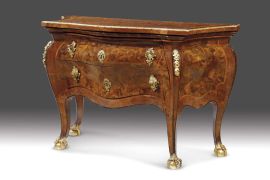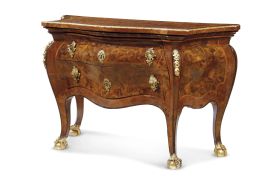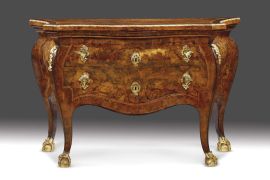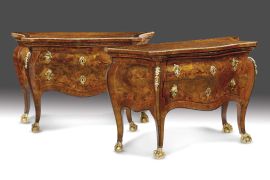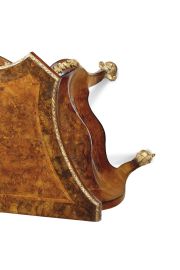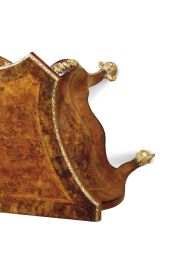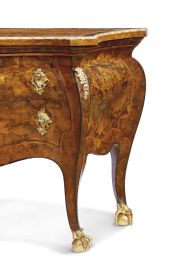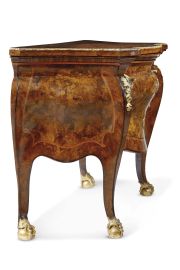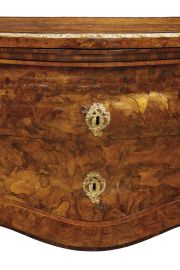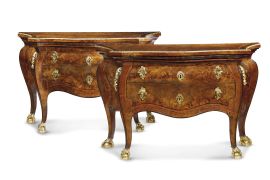A PAIR OF MID-EIGHTEENTH CENTURY COMMODES, PAPAL STATE - ROME
poplar carcase, with elm and walnut burl veneers, padauk and satinwood inlays, wood and gilded bronze mounts, 88 x137.5 x 58 cm
The rhythmically alternating concave and convex shapes, highlighted by the light and dark wood inlays, firmly place this pair of commodes in the artistic climate of the mid-eighteenth century. During that period, throughout Italy, from north to south, the lavish and even ostentatious Baroque style was making way for the more graceful Rococo that transposed society’s natural evolution towards a more relaxed manner into art.
Almost as if to counteract the love of symmetry that had characterized the seventeenth century with furniture that often recalled architecture, in the Age of the Enlightenment lines became quick and quite frequently daring, in a continuous play of “full and empty”, and light and dark often enhanced by different colors and species of wood. There was no room for straight lines unless they were used to contrast curves, and this can be seen on the tops of the commodes shown here. The gently curving line is brusquely interrupted in the chamfered corners, creating an effect that is strengthened by the chromatic contrasts of the two types of burl with a lighter wood contour, and then it is all enclosed by gilded wood carved in a motif of concave ovals alternating with diagonal lines that recalls bronze trims.
However, it is not so much the top as the front and sides that prove that this pair dates from the period of Louis XV. The shape, that first arches boldly inward immediately below the top, suddenly bursts into bombé on the front and sides, to descend to the apron with its gentle concave curves. The front edges that resemble pilaster strips, albeit without classic geometric stiffness, also continue the effect, opening into a wide outward curve, and then descending in the opposite direction down to the legs which also repeat the sinuous lines as they flare slightly.
The shape of the commodes, with sides that widen at the back permit a frontal view, highlight the sinuous contours of the sides, enhancing the rhythmically fluent lines, in a play of curves that continues from the front to the sides.
It is as much because of the shape as the gilded, plant-motif mounts that enhance the escutcheons, the pulls and the top parts of the edges, that these commodes are significantly comparable to other mid-eighteenth century pieces made for important clients in Rome. The lavish gilded bronze and wood mounts, along with different types of woods are similar to the Boncompagni-Ludovisi commodes (see fig. 1). The shape of the tops, which in our pieces are burl rather than marble, with the oval-motif trim, along with the curvilinear shape that creates “full and empty” spaces as it moves along the corners from the front, and the contoured drawers that follow and emphasize the overall pattern of the body, make our pieces similar to the one in the F. Tuena Collection (see fig. 2).
Comparative Bibliography
G. Lizzani, Il mobile romano, Milan 1970, pp. 119-120;
A. González Palacios (ed.), Fasto romano - dipinti, sculture, arredi dai palazzi di Roma, Rome exhibition catalogue, Palazzo Sacchetti, 15 May - 30 June 1991, Rome 1991

